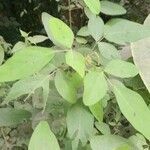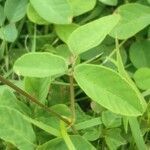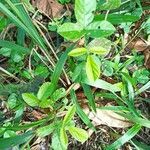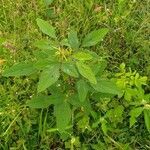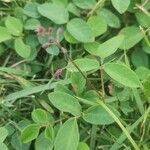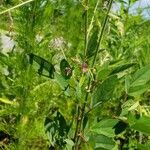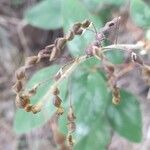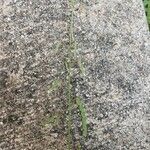Herbaceous from a woody base, or frutescent, up to ± 1 m. tall, branching from the base; stem terete, striate, uncinulate-pubescent and somewhat pilose.. Leaves 3-foliolate (or rarely some 1-foliolate); stipules obliquely ovate-attenuate, 3–12.5 mm. long, 1–7 mm. wide, striate, ciliate, puberulent on outer surface, becoming glabrous, long-persistent, often reflexed; petioles pubescent as stem, 0.5–5 cm. long; rhachis similar, 0.3–2 cm. long; leaflets elliptic to ovate, mostly obtuse at apex, cuneate at base, with prominently reticulate venation, sparsely to moderately uncinulate-puberulent and pilose on both surfaces, ciliate, the terminal 2–8 cm. long, 1–3 cm. wide, the lateral similar but slightly oblique, 1–5 cm. long, 0.5–2.8 cm. wide.. Inflorescences axillary and terminal, racemose to racemose-paniculate; rhachis striate, uncinulate-puberulent, moderately to densely and finely glandular pilose, becoming less densely so in age; primary bracts, each subtending 2 or more pedicels, narrowly ovate-attenuate, 3–6.5 mm. long, 0.5–1.5 mm. wide, striate, minutely puberulent on abaxial surface; secondary bracts, each subtending 1 pedicel, similar, smaller, ± 2 mm. long and 0.5 mm. wide; pedicels with pubescence similar to that of rhachis, rather stiff and ascending to spreading at maturity, 0.5–1.7 cm. long.. Flowers red to mauve or green with red or mauve margins, or white or yellow.. Calyx minutely puberulent and rather abundantly pilose throughout, teeth of both lobes somewhat ciliate; central tooth of lower lobe long attenuate, 3–4 mm. long, lateral teeth 2–3 mm. long, upper bifid lobe 2–3 mm. long.. Standard obovate, slightly retuse at apex, gradually narrowed to base, 2.5–3.5 mm. long, 2 mm. wide; wings obtusely oblong, auricled and shortly clawed, 2.5–3.5 mm. long, 1–1.5 mm. wide; keel-petals obliquely oblong, broader above, clawed for ± one-third their length, 3–4 mm. long, 1 mm. wide.. Fruit 5–7-articled, isthmi between the articles central; stipe 0.5–1 mm. long; articles mostly orbicular in outline, sometimes with margins alternately revolute and so appearing rhomboidal, 3–5 mm. long, 2.5–4 mm. wide, uncinulate-pubescent throughout.. Seed ± reniform, 1.5 mm. long, 1 mm. wide.
Herbs, perennial, erect, 50-200 cm tall. Stems with hooked hairs, sometimes intermixed with long hairs. Leaves 3-foliolate, rarely 1-foliolate; petiole 1-8 cm, hairy as stems; terminal leaflet blade elliptic or ovate, 3-8(-14) × 1.5-3(-6) cm, both surfaces sparsely hairy, base cuneate, apex obtuse. Racemes or sometimes panicles, terminal or axillary; rachis with dense minute hooked and glandular hairs, 2-flowered at each node. Pedicel filiform, to 1.7 cm at fruiting, hairy as rachis. Calyx 3-4 mm, 5-parted; lobes longer than tube. Corolla red, white, or yellow; standard obovate, 2.5-3.5 × ca. 2 mm, base attenuate, apex emarginate; wings oblong, base auriculate, shortly clawed; keel obliquely oblong, clawed. Legume narrowly oblong, 1.5-2 cm, both sutures constricted between articles, moniliform, densely gray-yellow hooked hairy, (3-)5-7-jointed. Fl. and fr. Jul-Sep. 2n = 22.
Leaves 3-foliolate; leaflets 1.2–9.5 × 0.6–5.5 cm, elliptic, rhombic or elliptic-oblong to ovate-lanceolate, rounded and usually mucronulate at the apex, cuneate to rounded at the base, puberulous on both surfaces and with some longer pubescence on the nerves beneath; petiole 0.7–7 cm long; rhachis 4–22 mm long; petiolules 1.5–3 mm long; stipules 6–13 × 1.5–4 mm, obliquely ovate, broad at the base and with attenuate tips, puberulous and ciliate, persistent.
Inflorescences terminal and axillary, 11–30 cm long; peduncle 5–10 cm long; pedicels 8.5–17 mm long, puberulous and with longer hairs; primary bracts each subtending 1–4 pedicels, 3–6 × 0.8–1 mm, lanceolate, puberulous, soon deciduous; secondary bracts also present.
Fruits 10–32 mm long, of (1)3–7 articles; each article 3–6.5 × 3–4 mm, elliptic or almost round, uncinulate-pubescent and minutely glandular, reticulate, strongly constricted between articles, the necks being centrally placed, c. 0.8 mm wide; stipe 2.5 mm long.
Calyx pubescent and puberulous and with some tubercular-based glandular hairs; tube 1–1.5 mm long; lobes 1.5–2 mm long, narrowly triangular, the upper pair joined to form a slightly 2-fid triangular lip.
Seeds chestnut-brown or greenish or yellow-brown, 3 × 2 × 1 mm, compressed-ellipsoid, slightly wider at one end; hilum minute, central.
Stems often several from the base, branched or unbranched, puberulous and with tubercular-based glandular hairs.
Standard pink, blue-mauve or blue-green, 5–6 × 3–3.5 mm, narrowly obovate.
Erect perennial herb or undershrub 0.4–1.5 m tall.
Erect herb or undershrub
Very thin flaccid leaves
Introduced in our area.
Pubescent branches
Twisted fruits

